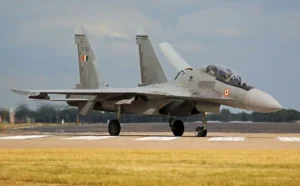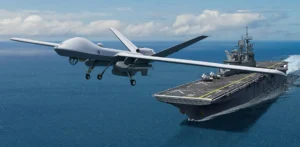In a first-of-its-kind footage that has taken the internet by storm, a German-supplied Gepard self-propelled anti-aircraft gun (SPAAG) was caught on camera engaging a Shahed kamikaze drone and eventually annihilating it.
Rafale For Bangladesh? 1st Time In 33 Years, French President Visits Dhaka As Dassault & Eurofighter Compete For BAF Deal
Touted as the best anti-aircraft gun in the world, the Gepard could be seen in the video launching a barrage of 35mm shells on the Shahed suicide drone dispatched by Russian forces. The video was first posted to Facebook by Ukraine’s Southern Air Command.
The caption accompanying the Facebook post read: “Video of the combat work of the soldiers of the ‘Southern’ air command against the ‘Shahed-136/131′ attack UAVs on the night of September 7, 2023 in Odesa [Oblast, southern Ukraine]! The German’ Gepard’ hunted down the enemy ‘shaheds’!”
Later, the Ukrainian Air Force posted the video to Platform X (previously Twitter), which went viral soon after. The 31-second footage shows the Gepard firing on the Shahed (either the Shahed-131 or Shahed-136) as soon as it was located. The shells are launched quickly until the drone is hit, to which the crew could be heard rejoicing with a “yes!”
This is not the first time a video of a Gepard engaging Russian kamikaze drones has been published. Earlier, a video compilation surfaced on social media showing the Gepard engaging drones on two different occasions, resulting in the shooting down of all the drones that these anti-aircraft guns fired on.
“Gepard” vs “Shahed”
Spoiler: “Gepard” won 🫡
🇺🇦🤝🇩🇪 pic.twitter.com/LlauuslraB— Ukrainian Air Force (@KpsZSU) September 7, 2023
However, the latest video was shot by the Ukrainian crew operating the system while it engaged the kamikaze drone, providing the first-ever first-person view of such engagement. The Gepards have become a very crucial part of Ukraine’s air defense, besides the many cutting-edge western systems that Kyiv has fielded.
Due to its intended usage as a point defense system against various low-flying aerial targets, the Gepard has proven to be quite effective against Russian drones and, in certain situations, cruise missiles. Russian forces have launched multiple attacks using Iran-origin Shahed drones, making this duel between the two systems a near-everyday occurrence now.
Lieutenant General Sergei Nayev showed the work of German 1A2 Gepard on Shaheds in the skies of Zhytomyr region on August 19 and 30, all objects were shot down pic.twitter.com/92JEO9fIA1
— Oriannalyla 🇺🇦 (@Lyla_lilas) September 6, 2023
Germany has already shipped six Gepards to Ukraine, and another 46 are believed to be in the pipeline. In April last year, Berlin decided to deliver its decommissioned Gepards to Ukraine. However, only in August of 2022 was the first visual proof of their deployment by Kyiv’s forces recorded.
Even the US Army funded the transfer of an unspecified number of Gerpards from Jordan to Ukraine, albeit the Dutch variant instead of the German one, as reported by EurAsian Times.
The latest video, incidentally, emerged just days after manufacturer Rheinmetall and the German Defense Ministry announced that the country had delivered the first shipment of new ammunition for the Gepard to Ukraine. According to the German military, this initial delivery includes a “five-digit number” of munitions.
Moreover, the latest media reports have indicated that Ukraine is now working on a war footing to brace for another winter in which Russia’s Shahed kamikaze drones are expected to aim for the crippling of Ukraine’s power infrastructure. However, Ukraine has bolstered its air defenses with cutting-edge systems, including newly donated German-made Gepard systems.
The Ukrainian military went so far as to tell the media that one such system could shoot down five Shaheds since it was first deployed a month ago, which loosely translates to a 100% success rate. “We had fewer (systems) last winter. Now we have been given more, and the effectiveness will be better,” said General Serhiy Naiev, commander of the Joint Forces of the Armed Forces.
Why Is The Gepard Still A Force To Reckon With?
The Flakpanzer Gepard, made in Germany, consists of a two-person turret housing a pair of radar-guided 35-millimeter autocannons and a Leopard 1 tank chassis with room for a driver. The Gepard, equipped with its radar, can fire streams of 35-millimeter shells three miles away.
The Gepard is equipped with independent search and tracking radars, with the former at the front and back of the turret and the latter at the back and front. The radars enable search while moving, 360-degree scanning, target monitoring, clutter suppression, and mono pulse tracking.
Twin Oerlikon KDA, 35mm cannons, are placed on the Gepard and are controlled by a two-person electric power system. The weapons have a belt feed that operates automatically. The barrel measures 90 calibers (3,150mm) in length.

The two barrels fire at a rate of 1,100 rounds per minute. 320 rounds of anti-air ammunition and 20 rounds of anti-ground target ammunition are included with each 35mm gun. The guns can fire various standardized 35mm rounds, including the brand-new FAPDS rounds (frangible armor-piercing discarding-sabot ammunition).
The FAPDS rounds have a muzzle velocity of more than 1,400 meters per second. Eight smoke dischargers are installed on either side of the Gepard turret. KMW developed a Gepard missile system based on the Stinger surface-to-air missile system. Owing to their tremendous mobility, they may be quickly steered to forward locations as needed.
Gepards continue to be essential assets for the defense of important cities and infrastructure deep inside Ukraine, alongside additional short-range air defense (SHORAD) capabilities provided to Ukraine by Western partners. Moreover, it is believed to be more cost-effective when shooting down the cheap Shahed drones than systems like the IRIS-T.
Source link
#Ukraines #Gepard #SPAAG #Russias #Shahed136 #Suicide #Drones #Face #Battlefield








